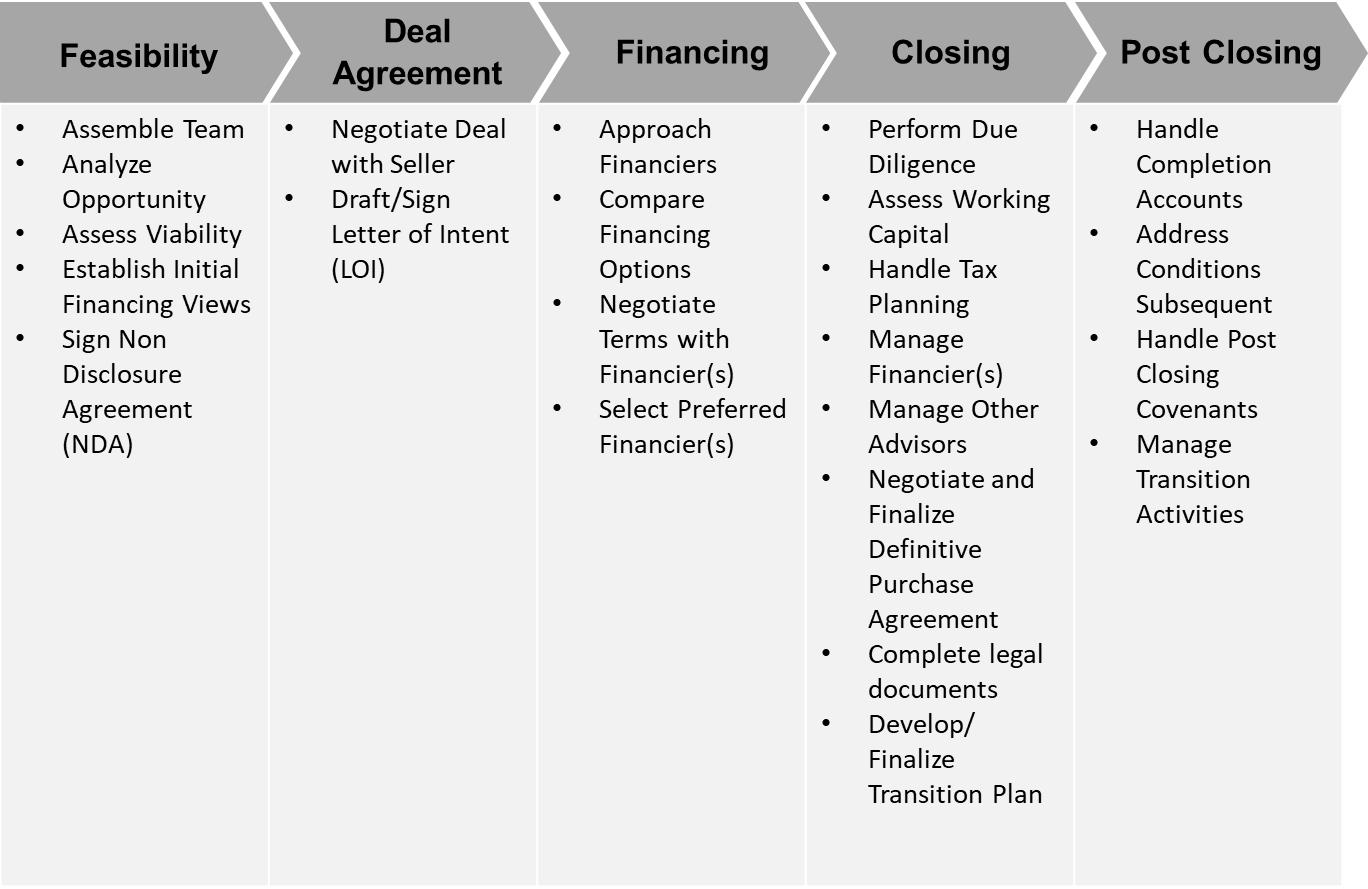Considering a Management Buyout (MBO)?
– Part 5 of a 5 Part Series on MBOs
The MBO Process
Undertaking an MBO is a time consuming and complex process. In general, an MBO will follow a five step process from initiation to completion. These steps will generally proceed in sequence although there is overlap and parallel activity that occurs as the deal matures from inception to closing. An MBO process may take three to six months to complete and some of the stages can run concurrently. The MBO process involves negotiations with many parties and can be fraught with complexities. To management, this process is time consuming, wearisome, and emotional. No two MBOs are ever the same and few are fast and easy.

Once the initial MBO interest has been established, it is essential for the management team to consult an experienced and knowledgeable adviser. Managers are unlikely to be involved in more than one MBO in their lives and appropriate advice at an early stage is sensible when embarking on such a complex and sophisticated transaction. In addition, the management team will find itself under immense pressure and severe time constraints during the process, in addition to having to fulfil its continuing management responsibilities. An adviser should be able to estimate the management team or seller’s chances of success at the outset and so save a lot of time and energy. Assuming the chances are good, then the management team or seller will need advice on how and when to approach the seller or management team. Prior to a formal MBO offer being made, the adviser will be prepared to have exploratory meetings in absolute confidence and to advise upon the feasibility of the MBO.
The Five Step MBO Process

Timeline and Costs
An MBO is a complex transaction involving numerous parties, often with conflicting needs despite an overall common goal. Consequently, the time taken to complete an MBO varies significantly. Unless the transaction has arisen from a distressed situation (e.g. actual or threatened insolvency) then it is likely that the transaction will take between three and six months to complete. It can be further extended if there is a “stand-off” between buyer and seller. Of course, with a degree of pragmatism and willingness it is possible to complete a deal much more quickly, perhaps even within a matter of weeks, particularly if the financing takes the form of asset-based lending and there is no private equity involvement. This is because the asset- based lender’s principle focus is on the security value of the assets rather than on the dynamics of the business, its markets and management.
In terms of the cost of the MBO process, as a rough guide this could amount to between 5% and 15% of the transaction value, depending on the size of the deal and the sources of financing.
Who pays if the deal does not happen?
The majority of the costs should be contingent upon a successful completion of the MBO; therefore, protecting the management team from any material personal liability. To the extent the seller is willing to underwrite some costs then this can reduce the overall cost burden when the deal completes as well as demonstrate the seller’s commitment to the transaction.
After the MBO
Many management teams put a “100-day plan” in place to cover the detailed aspects that need to be addressed in the weeks following closing. Communicating to staff, customers and suppliers is a key early task. It is possible that your financiers have insisted that any key customers or suppliers were advised of the deal pre-deal closing to ensure business would continue on the same basis. However, it is still important for you to communicate to all of the key groups your vision so as to carefully instill the necessary confidence in the new ownership. It may also be necessary to install new independent systems for financial reporting if you were previously part of a larger group. Even if the business was independent, the systems may need to be updated to ensure that they provide necessary and timely information to you and your financiers.
A private equity firm is likely to require the appointment of a Chairman and/or Non-Executive Director (possibly a member of the private equity firm’s team) to bring relevant experience and to fill in any skills gaps on the team. These discussions are likely to have already been underway but may not be finalized until now. A Chairman or Non-Executive Director should not be seen as a hindrance but, if the right one is chosen, they can bring their experience and skill set to the table for the benefit of the business. They can possibly open new doors and share their previous experience on how to deal with certain matters. Finally, positioning the business appropriately and planning for a successful exit cannot start soon enough and will be encouraged by the private equity firm at all stages of the company’s development.
